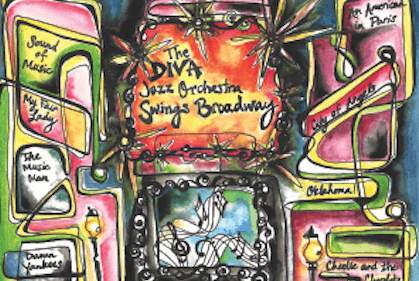30 Years After Launching, the Music Is What’s Most Notable About These Swinging DIVAs
The orchestra was organized to provide opportunities for female musicians, a noble aim that happily is less overwhelmingly necessary these days.

The DIVA Jazz Orchestra was founded in 1992 by Stanley Kaye, a dear man who was the best friend of virtually everyone in the jazz world, the showbiz world (the Hines Brothers and Michele Lee were among his star clients), and the world beyond. He was equally beloved by both Buddy Rich and George Steinbrenner, icons in very different fields who inspired a lot of rather extreme emotion.
Kaye and his co-founder, drummer-bandleader Sherrie Maricle, organized the DIVA orchestra for a very specific purpose: to provide opportunities for female musicians. That was a noble aim then and it remains so now, though it’s satisfying to report that it’s less overwhelmingly necessary 30 years later. These days, female musicians, composers, and bandleaders are far more visible even in bands that don’t make a point of it. (New York is particularly rich in outstanding female bass players.)
Case in point: The best live jazz big band music I’ve heard so far in 2022 is that of Maria Schneider, leading her orchestra in a return (post-Covid) engagement at Birdland a few weeks ago. We don’t listen to Ms. Schneider’s music because she is a woman, but rather because she is perhaps the most thoughtful and creative of all composers currently creating large-format works for the jazz ensemble. Likewise, the release of a new album by DIVA — titled “The DIVA Jazz Orchestra Swings Broadway” — is a very welcome event not because it’s an all-female group, but because Ms. Maricle and her 15 hard-swinging DIVAs constitute one of the most consistently satisfying big bands of the millennial era.
The album kicks off with “Heart,” which serves not only as opener, but as a kind of a rallying cry, a call to arms.The arrangement by Steven Feifke rocks mightily, and the “Damn Yankees” classic is indeed rendered not only with proper danceability but plenty of appropriate optimism and warmth.
“With Every Breath I Take” is both arranged and played by trombonist Sara Jacovino in a vaguely Stan Kenton-esque style, using musical dissonance as a signifier for the cognitive dissonance, the angst and loneliness that the character (in “City of Angels”) feels at this point in the narrative. Like most of the rest of the numbers here, it’s a superb example of telling a story using an instrumental ensemble and a solo player — but without the words.
Midway through the album, we get two consecutive Rodgers and Hammerstein opening numbers. “The Sound of Music’” alludes very directly to the Count Basie tradition, starting with its minimal, even tinkly upper treble piano introduction and the elegant, danceable phrasing of the central melody. “Oh What a Beautiful Morning” is now a 4/4 swinger instead of a more contemplative waltz, and remains an enthusiastic salutation for a new day.
There’s also a sweetly romantic, not sentimental ballad, “Love Who You Love.” It’s a lovely, lyrical waltz from “A Man of No Importance,” and notable as a rare big band interpretation of virtually anything by Stephen Flaherty and Lynn Ahrens, whose excellent scores are too often overlooked by the jazz world.
Along the way, there’s a bass-centric “Man I Love” in which Noriko Ueda plays pizzicato against an angular, boppish background by Mike Abene. (Most of us never realized the tune is especially appropriate for a female instrumentalist — Ms. Ueda dedicates it to her husband.)
There’s also a thrilling Latinate en clave treatment of “Pure Imagination” featuring Jamie Dauber on flugelhorn and Roxy Cross on tenor saxophone; it could have come from a show titled, “Charlito and el Cigar Factory.”
We end with a rousing “Get Me to the Church on Time,” the “Eleven o’clock” number from “My Fair Lady,” which makes for a barn-burner of a finale. It climaxes in an standout sax battle between the band’s two altos, Mercedes Beckman and Alexa Tarantino, and a drum solo by the leader.
Yet the most ambitious number here may well be “76 Trombones,” which goes through several rhythmic modulations, starting as a march, detouring through a dixieland passage as well as an unexpected quote from the 1915 “Lassus Trombone,” before it settles into a groove as a solid 4/4 swinger.
This album is the second jazz-goes-Broadway album I’ve had the pleasure of reviewing in the last month, which may indicate that this idea is now a trend again.
Perhaps, since Hugh Jackman is currently the sensation of Broadway in “The Music Man,” Sherrie Maricle and company will give us a curtain call in the form of a full-length DIVA treatment of Meredith Willson’s classic score. Who knew that Professor Harold Hill was really a jazz guy at heart?

